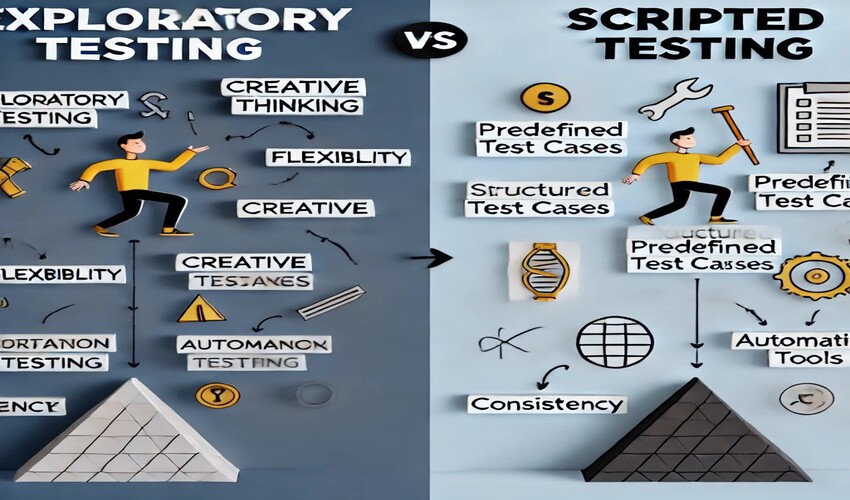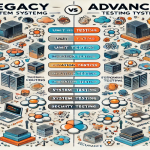Testing occupies one of the key positions in the contemporary context of software development that is focused on evaluating the quality, functionality, and safety of the applications. Of all the testing strategies, two that could be singled out are exploratory testing and scripted testing,, which have definite advantages and disadvantages. Choosing which approaches to apply depends on the need of the project, its degree of difficulty, and the phase of growth. It is therefore necessary to take our time and consider some of the differences in these two testing methodologies in the current world of fast development cycles.
What is Scripted Testing?
Scripted testing is done based on certain flowcharts mentioned in the test cases or test scripts. The endings of these steps are made very carefully by testers to ensure that definite functions or processes in the software are working sufficiently.
Key Characteristics of Scripted Testing:
Structure: Test cases are documented, meaning testing coverage can easily be checked together with the tests carried out.
Reproducibility: Since the tests themselves are prescripted, practices may be replicated and delivered by other testers, which is useful for regression testing and version-to-version homogeneity.
Clear Objectives: Scripted testing is one of the manual testing approaches, whose aims at testing verified functionality and conditions based on standard requirements.
Advantages of Scripted Testing:
Consistency: It allows all test cases to be tested systematically because it eliminates human-induced variation.
Documentation: Scripts, especially well documented, afford traceability and accountability, especially where the business or industry has compliance issues.
Automation-Friendly: This type of test is easily customizable and frequently runs in CI environments to execute significantly faster than manual runs.
Limitations of Scripted Testing:
Rigidity: Scripted testing may fail to integrate other unforeseen issues or situations. This is because testing only goes around the outlined paths.
Time-Consuming: An important drawback of creating detailed test cases is that they consume time and will, therefore, slow down the testing phase.
Less Flexibility: Requirement change is also not well supported by scripted testing, which is often a problem in current Agile software development.
What is Exploratory Testing?
Exploratory testing is less structured and less precise in practice. The tester interacts with the system and constantly changes his strategy depending on the application responses. The intent, therefore, must be to find out anything that could conceivably be wrong or improved that is not likely to show in script-driven assessment.
Key Characteristics of Exploratory Testing:
Real-Time Testing: Testers script and conduct tests based on their impulses, experience or the reaction of the application.
Adapts to Changes: Exploratory testing is particularly beneficial in Agile projects, as a customer’s requirements may change during the development phase.
Focused on Discovery: This method’s strengths lie in discovering unknown problems, such as those related to usage, security, or performance.
Advantages of Exploratory Testing:
Flexibility: Exploratory testing has a big advantage in that the tester can move through the application without having to stick to a script and can therefore come across new defects.
Efficient in Unstructured Projects: Exploratory testing can be implemented where there is little documentation or where the requirements are continuously changing frequently.
Emphasizes Creativity: Testers, unlike those who work according to scripts, can more freely get to the problem, finding important nuances that can be overlooked.
Limitations of Exploratory Testing:
Less Documentation: Exploratory testing does not generate detailed documentation that may be used to further trace the problem or replicate the actions to be taken.
Difficult to Measure Coverage: This is why coverage can be an issue: the approach used depends on the tester and one’s intuition.
Cannot Be Automated: Exploratory testing is still performed manually, which prevents the general application of this approach in large-scale projects.
Which Model is Suitable for Contemporary Software Development?
In the current development setting particularly the Agile and DevOps, environment, the change is fast and testing needs to be adequate, appropriate, and timely. Exploratory testing and scripted testing are two testing methods, with their strengths and weaknesses, but they are in many cases used together.
Scripted Testing for Automation and Regression: Scripted testing performs best in situations, where it is critical to have less variability or flexibility, and everything is to be documented and automated. It is most beneficial for regression testing in CI/CD because it constantly checks existing features with no need for additional coded tests. Scripted testing is not quite efficient for large-scale project testing that needs detailed small-aspect tests of certain features since nothing under test remains unexamined.
Exploratory Testing for Discovery and Adaptation: Exploratory testing becomes very useful when used in the early stages of development or when the software is greatly dynamic. This way the testers can be flexible and identify problems that would not be so easy to see in case of written test cases. Where frequent feedback and quick feedback cycles are valuable, exploratory testing can indicate constant software quality.
Exploratory Testing and Scripted Testing Comparison
| Aspect | Exploratory Testing | Scripted Testing |
|---|---|---|
| Approach | Unscripted, tester-driven | Predefined test cases |
| Flexibility | Highly flexible | Rigid and structured |
| Documentation | Minimal, session-based documentation | Detailed and traceable |
| Skill Requirement | Requires experienced testers | Less skill-intensive |
| Automation | Cannot be automated | Ideal for automation |
| Ideal Use Case | Early development, dynamic environments | Regression, stable features |
| Edge Case Detection | Excellent at discovering edge cases | Limited edge case detection |
| Testing Speed | Faster feedback | Slower due to pre-written scripts |
| Adaptability to Changes | Highly adaptable to changes | Less adaptable to frequent changes |
A Hybrid Approach: The Best of Both Worlds
In the current software development context then, it is unclear that either exploratory or scripted methodologies are the right answer in and of themselves, but perhaps some blend of the two. A mix of the scripted test or a high level of automating important features, a model that pairs scripted technique with the automated systematic test for main aspects while exploratory technique for secondary aspects, unknown and new features.
Use Case Example: This technique can also be used in early development, say, to leverage, for example, exploring new functionality and receiving reactions. After features get set, it is easy to create script conditions to avoid a negative effect on functionality, as seen in future releases.
CI/CD Integration: Scripted testing is the best for continuous integration while exploratory testing can also be carried out synchronously although common in sprint reviews or after any change.
Conclusion
This is a fact that nobody is saying that testing with only scripted test cases is superior to testing that uses only exploratory testing. Modern software development mainly uses both approaches to have better coverage, and feedback as well as to capacity to accommodate changes in requirements. Scripted testing is rigorous; it is measurable and repeatable, easily automizable, with well-defined test cases; on the other hand, in exploratory testing scenarios are quite fluid and free-handed; therefore, it is very important in today’s development context.

Software Testing Lead providing quality content related to software testing, security testing, agile testing, quality assurance, and beta testing. You can publish your good content on STL.



